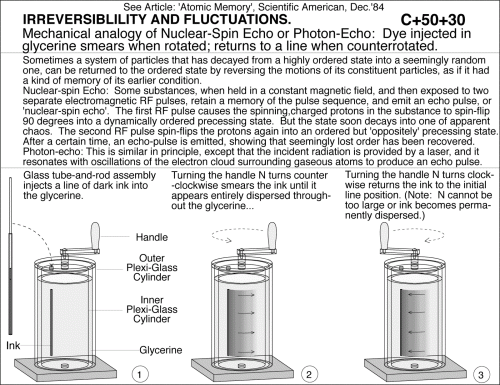Drum in glycerine rotates to smear line of dye into a plane and back.
Primary tabs
Mechanical analogy of Nuclear-Spin Echo or Photon-Echo: Dye injected in glycerine smears when rotated; returns to a line when unrotated. Glass tube-and-rod assembly injects a line of dark ink into the glycerine. Turning the handle N turns counter -clockwise smears the ink until it appears entirely dispersed throughout the glycerine... Turning the handle N turns clockwise returns the ink to the initial line position. (Note: N cannot be too large or ink becomes permanently dispersed.) Sometimes a system of particles that has decayed from a highly ordered state into a seemingly random one, can be returned to the ordered state by reversing the motions of its constituent particles, as if it had a kind of memory of its earlier condition. Nuclear-spin Echo: Some substances, when held in a constant magnetic field, and then exposed to two separate electromagnetic RF pulses, retain a memory of the pulse sequence, and emit an echo pulse, or 'nuclear-spin echo'. The first RF pulse causes the spinning,charged protons in the substance to spin-flip 90 degrees into a dynamically ordered precessing state. But the state soon decays into one of apparent chaos. The second RF pulse spin-flips the protons again into an ordered but 'oppositely' precessing state. After a certain time, an echo-pulse is emitted, showing that seemingly lost order has been recovered. Photon-echo: This is similar in principle, except that the incident radiation is provided by a laser, and it resonates with oscillations of the electron cloud surrounding gaseous atoms to produce an echo pulse. 1 2 3 See Article: 'Atomic Memory', Scientific American, Dec.'84 KINETIC THEORY AND GAS MODELS.
UCB Index:
C+50+30
PIRA Index:
4F10.10
UCB Taxonomy:
Popularity:
- Log in to post comments

